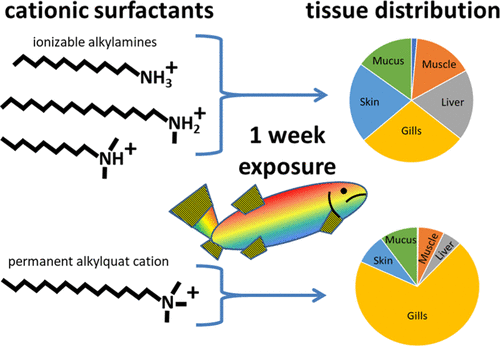当前位置:
X-MOL 学术
›
Environ. Sci. Technol.
›
论文详情
Our official English website, www.x-mol.net, welcomes your
feedback! (Note: you will need to create a separate account there.)
Tissue Distribution of Several Series of Cationic Surfactants in Rainbow Trout (Oncorhynchus mykiss) Following Exposure via Water.
Environmental Science & Technology ( IF 10.8 ) Pub Date : 2020-02-16 , DOI: 10.1021/acs.est.9b07600 Amelie Kierkegaard 1 , Chang'er Chen 1, 2 , James M Armitage 3 , Jon A Arnot 4, 5 , Steven Droge 6 , Michael S McLachlan 1
Environmental Science & Technology ( IF 10.8 ) Pub Date : 2020-02-16 , DOI: 10.1021/acs.est.9b07600 Amelie Kierkegaard 1 , Chang'er Chen 1, 2 , James M Armitage 3 , Jon A Arnot 4, 5 , Steven Droge 6 , Michael S McLachlan 1
Affiliation

|
Bioaccumulation assessment is important for cationic surfactants in light of their use in a wide variety of consumer products and industrial processes. Since they sorb strongly to natural surfaces and to cell membranes, their bioaccumulation behaviour is expected to differ from other classes of chemicals. Divided over two mixtures, we exposed rainbow trout to water containing 10 alkyl amines and 2 quaternary alkylammonium surfactants for 7 days, analysed different fish tissues for surfactant residues, and calculated the tissues' contribution to fish body burden. Mucus, skin, gills, liver and muscle each contributed at least 10% of body burden for the majority of the test chemicals. This indicates that both sorption to external surfaces and systemic uptake contribute to bioaccumulation. In contrast to the analogue alkylamine bases, the permanently charged quaternary ammonium compounds accumulated mostly in the gills and were nearly absent in internal tissues, indicating that systemic uptake of the charged form of cationic surfactants is very slow. Muscle-blood distribution coefficients were close to 1 for all alkyl amines, whereas liver-blood distribution coefficients ranged from 13-90, suggesting that the dominant considerations for sorption in liver are different than in blood and muscle. The significant fraction of body burden on external surfaces can have consequences for bioaccumulation assessment.
中文翻译:

经由水暴露后虹鳟(Oncorhynchus mykiss)中几种系列阳离子表面活性剂的组织分布。
考虑到阳离子表面活性剂在各种消费产品和工业过程中的用途,生物蓄积性评估非常重要。由于它们强烈吸附自然表面和细胞膜,因此它们的生物蓄积行为有望与其他类型的化学物质不同。将虹鳟鱼分为两种混合物,将其暴露于含有10种烷基胺和2种季烷基铵表面活性剂的水中,历时7天,分析了不同鱼类组织中表面活性剂的残留量,并计算了这些组织对鱼体负担的影响。对于大多数测试化学品,粘液,皮肤,腮,肝脏和肌肉各自至少占人体负担的10%。这表明外表面的吸附和全身吸收均有助于生物蓄积。与类似的烷基胺碱相比,永久带电荷的季铵化合物主要聚集在the中,而在内部组织中几乎不存在,这表明带电荷形式的阳离子表面活性剂的系统吸收非常缓慢。所有烷基胺的肌肉血液分配系数均接近于1,而肝脏血液分配系数介于13至90之间,这表明肝脏吸附的主要考虑因素不同于血液和肌肉。人体在外表面上的很大一部分负担可能会对生物蓄积性评估产生影响。所有烷基胺的肌肉血液分配系数均接近于1,而肝脏血液分配系数介于13至90之间,这表明肝脏吸附的主要考虑因素不同于血液和肌肉。人体在外表面上的很大一部分负担可能会对生物蓄积性评估产生影响。所有烷基胺的肌肉血液分配系数均接近于1,而肝脏血液分配系数介于13至90之间,这表明肝脏吸附的主要考虑因素不同于血液和肌肉。人体在外表面上的很大一部分负担可能会对生物蓄积性评估产生影响。
更新日期:2020-03-19
中文翻译:

经由水暴露后虹鳟(Oncorhynchus mykiss)中几种系列阳离子表面活性剂的组织分布。
考虑到阳离子表面活性剂在各种消费产品和工业过程中的用途,生物蓄积性评估非常重要。由于它们强烈吸附自然表面和细胞膜,因此它们的生物蓄积行为有望与其他类型的化学物质不同。将虹鳟鱼分为两种混合物,将其暴露于含有10种烷基胺和2种季烷基铵表面活性剂的水中,历时7天,分析了不同鱼类组织中表面活性剂的残留量,并计算了这些组织对鱼体负担的影响。对于大多数测试化学品,粘液,皮肤,腮,肝脏和肌肉各自至少占人体负担的10%。这表明外表面的吸附和全身吸收均有助于生物蓄积。与类似的烷基胺碱相比,永久带电荷的季铵化合物主要聚集在the中,而在内部组织中几乎不存在,这表明带电荷形式的阳离子表面活性剂的系统吸收非常缓慢。所有烷基胺的肌肉血液分配系数均接近于1,而肝脏血液分配系数介于13至90之间,这表明肝脏吸附的主要考虑因素不同于血液和肌肉。人体在外表面上的很大一部分负担可能会对生物蓄积性评估产生影响。所有烷基胺的肌肉血液分配系数均接近于1,而肝脏血液分配系数介于13至90之间,这表明肝脏吸附的主要考虑因素不同于血液和肌肉。人体在外表面上的很大一部分负担可能会对生物蓄积性评估产生影响。所有烷基胺的肌肉血液分配系数均接近于1,而肝脏血液分配系数介于13至90之间,这表明肝脏吸附的主要考虑因素不同于血液和肌肉。人体在外表面上的很大一部分负担可能会对生物蓄积性评估产生影响。











































 京公网安备 11010802027423号
京公网安备 11010802027423号